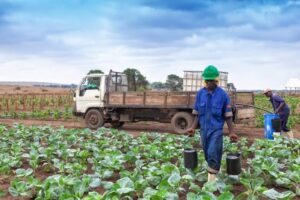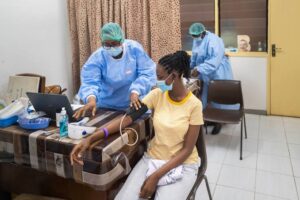
The narrative that education alone can be the ultimate weapon to conquer poverty has long been ingrained in our minds. However, it’s time to confront the truth: education, while vital, is just one piece of the puzzle. To make significant strides in ending poverty in this nation, we must embrace a multifaceted approach that encompasses practical strategies to address the root causes of age long poverty in our nation.
Practical and Sustainable Ways to End Poverty in Africa
1. Economic Diversification:
Over reliance on a single sector leaves economies vulnerable to fluctuations. By promoting economic diversification and investing in various industries, we can create more job opportunities and stimulate growth.
For instance, several African countries have been taking steps to diversify their economies to promote sustainable growth and reduce vulnerability to external shocks.
Here are some instances of economic diversification in African countries:
Rwanda. Rwanda has made significant efforts to diversify its economy by promoting sectors such as tourism, information technology, and services. The country has invested in infrastructure and technology to attract international businesses and become a regional hub for innovation and business.
Mauritius is known for its success in economic diversification. While initially reliant on the sugar industry, the country has expanded into textiles, tourism, financial services, and information technology. Today, it is a well-established offshore financial center and a popular tourist destination.
Botswana, traditionally dependent on diamond mining, has been working to diversify its economy. The government has invested in sectors like tourism, agriculture, and manufacturing. Additionally, Botswana has promoted local entrepreneurship and access to credit for small businesses.
Kenya has been diversifying its economy by focusing on services, particularly the technology sector. Nairobi has emerged as a tech hub, giving rise to numerous innovative startups. The country has also invested in horticulture, flower exports, and tourism.
Ghana has taken steps to diversify its economy by promoting non-traditional exports such as cocoa products, gold, and handicrafts. The country has also invested in tourism, attracting visitors to its rich cultural heritage and beautiful landscapes.
And so on.
These examples demonstrate the efforts of various African countries to move beyond dependence on a single industry and create a more robust and diverse economy. Economic diversification is crucial for sustainable growth, job creation, and overall economic stability in the region.
2. Infrastructure Development:

Building robust infrastructure, including reliable transportation networks, electricity, and communication systems, is crucial for if our economy will develop and attract foreign direct investments (FDI).
Many nations across the continent have been investing in various infrastructure projects to support their development goals. Here are some examples of infrastructural development in African countries:
Ethiopia: Ethiopia has been undertaking massive infrastructure projects, including the Grand Ethiopian Renaissance Dam (GERD), which is one of the largest hydropower projects in Africa. The country has also been expanding its road and railway networks to improve transportation and trade links.
Kenya: Kenya has made significant strides in infrastructure development, particularly in the transportation sector. The Standard Gauge Railway (SGR) connecting Nairobi to Mombasa and other regions has revolutionized freight and passenger transport. Kenya is also investing in modernizing its airports and urban infrastructure.
Rwanda: Rwanda has been investing in infrastructure to support its economic growth and development. The country has made improvements in roads, energy, and ICT infrastructure. Kigali, the capital city, is known for its well-planned urban development.
Ghana: Ghana has been focusing on improving its transportation infrastructure, with significant investments in road networks and ports. The expansion of Kotoka International Airport in Accra has boosted air travel and tourism.
These examples highlight the efforts of various African countries to enhance their infrastructure, supporting economic growth, and improving the overall quality of life for their citizens.
As these projects continue, they contribute to creating a more connected and prosperous continent. However, challenges in funding, project management, and maintenance persist and require continued attention to ensure sustainable development in Africa.
3. Access to Capital:
Facilitating access to capital for small and medium-sized enterprises (SMEs) and entrepreneurs can spur innovation and create sustainable livelihoods.
4. Agricultural Investment:

Several African countries have been taking steps to diversify their economies to promote sustainable growth and reduce vulnerability to external shocks. Here are some instances of economic diversification in African countries:
Mali – Sorghum and Millet Innovation Platforms: In Mali, agricultural productivity has received a significant boost through the establishment of Sorghum and Millet Innovation Platforms. These platforms serve as collaborative spaces, bringing together farmers, researchers, and policymakers to develop innovative solutions for crop improvement and farming practices. By promoting the cultivation of sorghum and millet, staple crops in the region, Mali is enhancing food security and lifting communities out of poverty.
Uganda – National Agricultural Advisory Services (NAADS): Uganda’s commitment to agricultural development is evident through its National Agricultural Advisory Services (NAADS) program. This initiative provides farmers with agricultural extension services, access to improved seeds, and support for irrigation systems. By equipping farmers with the necessary knowledge and resources, Uganda is bolstering agricultural productivity and ensuring food security for its citizens.
And so on.
These remarkable instances from different African countries illustrate the transformative power of technology, irrigation systems, and targeted support in enhancing agricultural productivity. By prioritizing sustainable agricultural practices and empowering farmers, these nations are making significant strides towards achieving food security and lifting communities out of poverty.
5. Social Safety Nets:
Implementing well-designed social safety net programs, like conditional cash transfers or food assistance, can provide a safety net for the most vulnerable, ensuring their basic needs are met.
6. Healthcare and Nutrition:

Investing in healthcare infrastructure, disease prevention, and nutrition programs is essential for a healthy and productive population.
Rwanda – Community Health Workers Program: Rwanda’s Community Health Workers (CHWs) program has been instrumental in providing essential healthcare services at the grassroots level. Trained community members offer preventive healthcare, health education, and disease surveillance, leading to improved health outcomes and reduced disease burden in the country.
Mozambique – Malaria Control Efforts: Mozambique has been actively combating malaria through various initiatives. These efforts include the distribution of insecticide-treated bed nets, indoor residual spraying, and prompt diagnosis and treatment. As a result, there has been a substantial decline in malaria-related morbidity and mortality in the country.
These examples illustrate how these three African countries have prioritized healthcare investment to promote better public health, disease prevention, and nutrition support, leading to a healthier and more productive population.
Empowering Women:
Recognizing the crucial role women play in the economy and society and implementing policies that promote gender equality can lead to a more inclusive and prosperous society.
8. Education and Skills Development:
While education alone cannot end poverty, it remains a critical component. Investing in quality education and vocational training can equip individuals with the skills they need for meaningful employment.
9. Good Governance and Transparency:
Tackling corruption and ensuring good governance are vital for creating an environment conducive to economic growth and poverty reduction.
10. Inclusive Growth:
Ensuring that economic growth benefits all segments of society, especially marginalized communities, is key to reducing poverty and inequality.
Education Alone is Not Enough to End Poverty:
While education is undeniably essential for personal development and empowerment, we must recognize its limitations in the fight against poverty. Access to quality education remains a challenge for millions due to factors like inadequate infrastructure and poverty.
Moreover, the traditional education system may not always align with the evolving job market, leaving graduates unprepared for employment opportunities. A focus solely on formal education neglects vocational training and practical skills that are equally crucial for economic advancement.
Addressing poverty in this nation requires a comprehensive approach that addresses the structural barriers that hinder access to education and economic opportunities. We must invest in improving education quality, supporting skill development, and creating an environment that fosters entrepreneurship and innovation.
To truly end poverty, we must look beyond the narrow confines of education. While education remains a cornerstone of progress, it must be accompanied by practical and holistic strategies that address economic, social, and systemic challenges. By embracing a comprehensive approach, we can chart a path towards a more equitable and prosperous future for all.